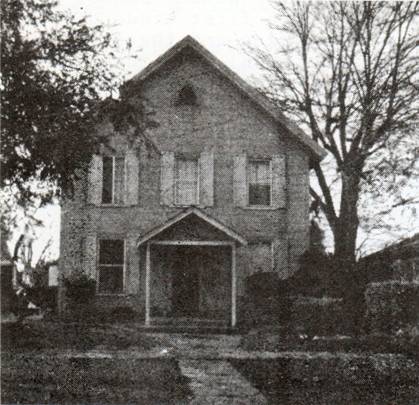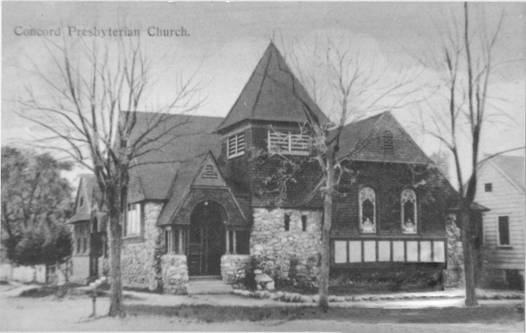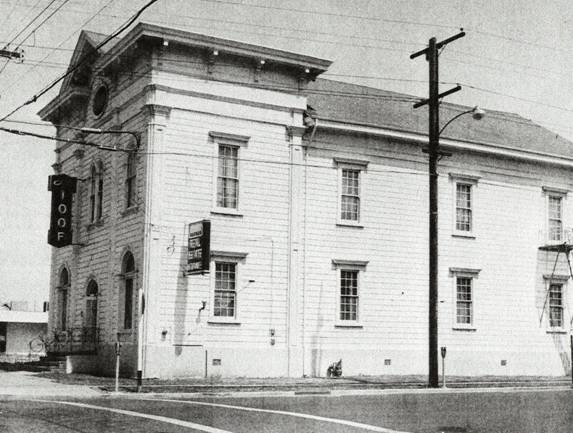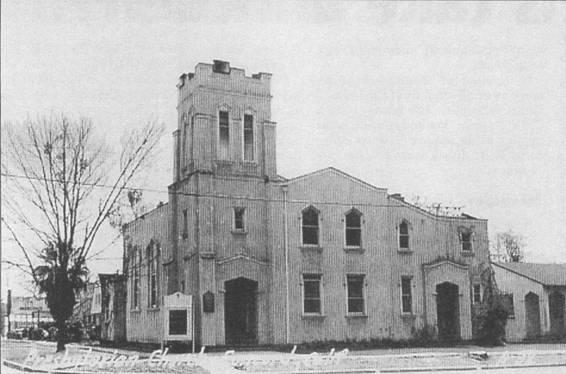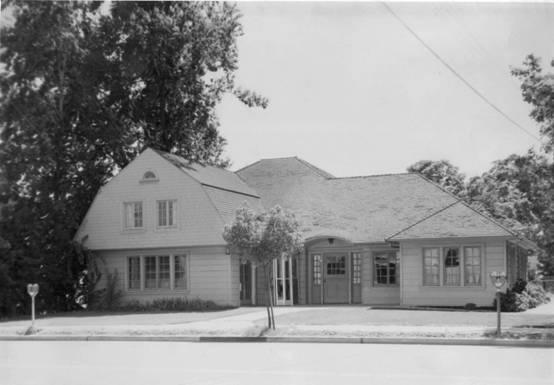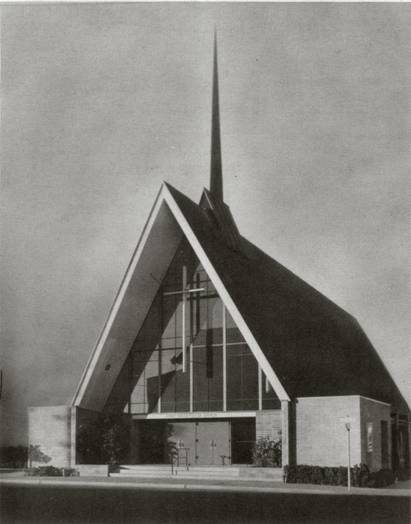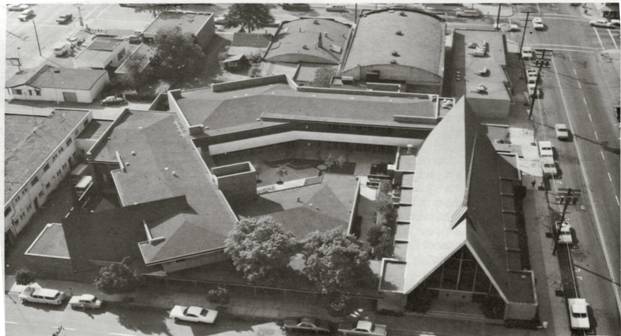Brief Church History
Timeline
- 1882
- The church was incorporated by the Presbyterian denomination.
- 1883
- The first church building is built and dedicated on Galindo Street, Concord.
- 1887
- The first marriage ceremony is held at FPCC.
- 1905
- The church is relocated to its current location at Salvio and Colfax in downtown Concord.
- 1915
- Church building destroyed by a fire.
- 1916
- A new building is constructed and dedicated after the fire.
- 1932
- FPCC celebrates its 50th anniversary.
- 1946 to 1956
- The congregation grew rapidly from 195 to 1,000 members.
- 1947
- The Lockwood Memorial Youth Center is dedicated.
- 1954
- The existing downtown church building is dedicated.
- 1965
- An administration and education complex is built by the congregation.
- 1976
- Heritage Senior Housing opens in Concord.
- Carillon (bells) installed and heard downtown
- 1980
- The church purchases a pornographic movie house on Grant Street in Concord.
- 1987
- The Showcase Theatre is remodeled and opens as the Presbyterian Community Center (PCC).
- 1996 – 2004
- New programs and community outreach are organized.
- 2019
- Rev. Dr. Johanna McCune Wagner accepts the call to be our senior pastor.
Foundation, 1882 – 1932
In 1882, the desire to establish a Protestant Church in Concord was expressed by the community of Concord, and so the Presbyterian denomination offered to organize and care for the church. The Reverend Duncan Monroe came to Concord in October of 1882 and the church was formed.
On December 30, 1882, the church was incorporated. The congregation built its first building on Galindo Street, on a lot donated by Samuel Bacon, who was a merchant and Concord's first postmaster. The building was dedicated on March 18, 1883. It seems wonderful to us now that a church was organized, and the building was constructed and dedicated in less than six months.
The first marriage ceremony that took place in the first church building was for Henry G. Bollman and Mattie Smith.
In 1905 the Galindo Street property was sold and lots were purchased on the corner of Salvio and Colfax Streets. A beautiful little church was built, with Sunday school rooms and a kitchen. Many in the community, some members of the church and some not, enjoyed the church suppers and ice cream socials. The town was small, with a population of about 500 and people got around by horse and buggy on unpaved streets.
On September 28 of 1915, the beautiful little church was destroyed by fire. The people were disheartened, but The Odd Fellows' Hall, which stood where the parking lot is today, was engaged for regular Sunday services.
A new church was quickly built and was dedicated on June 4, 1916. As nearly as can be judged from incomplete records, the membership at this time was about 85.
Establishment, 1932 – 1947
The Reverend Samuel Patterson led the congregation when the church celebrated its fiftieth anniversary in 1932. This happy occasion was observed by special music at the morning service, and a reception in the afternoon for members of the church. The progress of the church during these fifty years was considered slow and steady, but effective. The church had been maintained through difficult times, but it passed through its baptism of fire, literally, and was ready for greater things.
In November 1944, a building program was proposed for a new unit designed particularly for the needs of youth. This was to be known as the Claude A. Lockwood Memorial Youth Center, in honor of a former elder who gave his time to the young people of the church. The dedication of the Lockwood Memorial Youth Center, in October 1947, marked the 65th anniversary of the church and at this time 287 members belonged to the congregation.
Growth, 1947 - 1957
The population in the city of Concord continued to grow in 1947 and 1948. With the growth of the city, the difficulty in caring for the spiritual needs of the community was realized, so a board of deacons was elected by the congregation. From the very start, their care of the poor, ministry to shut-ins, preparation of the communion, and calls on church visitors deepened the consecration of the entire congregation. The congregation began to outgrow the building, and plans began to construct a larger one.
The new sanctuary proved to be one of the most imaginative examples of modern, functional buildings in the country. Constructed on the pattern of the old tent type parish church of North England, the pointed roof is supported on low buttressed side walls. The masonry block is exposed on both the exterior and the interior. The congregation had requested a straightforward design and a structure that would be dignified and church-like but which would also retain the warmth and intimacy so often found in English parish churches. The dedication of the existing church was held on April 11, 1954.
Expansion, 1957 - 1967
Beginning in January of 1964, a six-month moratorium was declared by the Session (the governing body of the church). Only the Session and the Church School continued to meet, and members of the congregation gathered to lay plans and priorities for the future. This moratorium fostered creative discussion, and out of the prayerful planning of the congregation grew many features of our church that continue to this day.
Due to a significant volunteer effort by the congregation, the buildings that make up the administration and education complex were completed in 1965 and added 22,000 square feet of space for administration, meeting, classroom and storage space. The project includes the buildings behind the existing church which is comprised by the nursery, several classrooms, the Christiansen Memorial Chapel, Fellowship Hall, the Fireside Room, and the High School Room.
In 1965, the life of our congregation began to blossom with renewed vigor. Our first woman elder, Doris Loveridge, was elected to the governing body of the church. The Deacons were reorganized into our now familiar parish system and increased in number to 99. By 1966, church membership reached 1246.
Evolution, 1967 - 1996
The mid-1970s was a time for increased emphasis on the needs of senior citizens both inside and outside of our congregation. After many years of prayer and careful planning, including the acquisition of crucial property, ground was broken on October 27, 1974, for the construction of The Heritage, an eight story, 196-apartment home for seniors. The building was occupied in November of 1975. Many Heritage residents have made a strong contribution to the life and service of our congregation.
The first woman minister to be ordained and serve in our church as assistant pastor, Reverend Penney Fujii, directed the opening of the Senior Adult Activity Center. The activity center coincided with the occupation of The Heritage.
In September, 1980, the church planned to buy a pornographic movie house in Concord known as the Showcase Theatre. This was done expressly with the purpose of removing the business from the city. The church reluctantly owned the porno theater for two years and accepted the rent until the lease ran out. Work began in earnest in 1985 to convert the theater into the present Presbyterian Community Center (PCC).
By 1987 PCC community activities included YMCA aerobics, Boy Scouts, Cub Scouts, the Concord Music Academy, wheelchair soccer, Hope League, and Samaritan Counseling. Programs came and went, but over the succeeding years others were introduced, including Teen Dance Club, Red Cross CPR, Karate, Special Olympics, Girl Scouts, step aerobics, Adult Children of Alcoholics, Bank of America Speakers Club and Friday Night Live, an alcohol and drug free program for teens that was used as a model to launch similar activities in other cities throughout the country.
In September of 2002, the Vineyard Church began to lease the PCC. This welcome turn of events has expanded the PCC’s use for the kingdom of God here in Concord.
A New Foundation, 1996 – 2007
New areas of learning developed during the late 1990s, early 2000s. In 1996, the Children’s and Youth Ministries were significantly revitalized, and renamed. The Children’s Sunday School Program became Kids Alive. The Junior High School program was relaunched as The Rock, and the Senior High School program became The Edge.
Our first Alpha class began in June 1999. The goal of Alpha is to provide a place where people can come and ask questions about the Christian faith and learn about the possibility of a personal relationship with Jesus Christ. The target audience consists of church visitors, friends of church members, and people within our church family who have questions about the Christian faith.
In April of 2002, we instituted Children’s Church as a way to meet the developmental needs of 1st through 3rd graders during the worship hour. The children sing praise songs, read the Bible, memorize scripture, and share their tithes and offerings in an age-appropriate way.
In September, 2004, a new mid-week children’s program called WATCH (Wednesdays at the Church) debuted. Sunday School lessons are reinforced on Wednesday nights through music, drama, projects, games and dinner. Half of the WATCH attendees were children who did not regularly come to our church on Sundays.
The celebration of the church sanctuary's 50th anniversary on April 18 was a major event in 2004. The Sunday after Easter was set aside to glorify Jesus and open wide the doors of our worship space to God's presence and our mission to our neighborhood. Over 375 people gathered to celebrate.
Today
The past generations of the family of believers at First Presbyterian Church of Concord, California are commemorated by this history. It is dedicated to the next generation.



